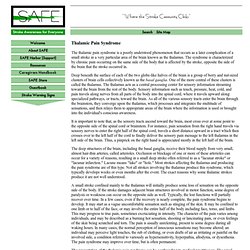

Home Modifications.
Physical Challenges. When the Pain Never Goes Away. Excerpted from "When the Pain Never Goes Away," Stroke Connection September/October 2003.

(Last science update March 2013) “I feel like I have no skin, only flesh showing, and it’s being rubbed or scratched constantly. My leg feels like it’s made of solid wood, and my skin is too tight. Someone is ripping at my arm, hand, face and foot with razorblades constantly. My fingers are made of metal worms that move constantly. “I cannot let air blow against my affected side because it hurts too much. “I have been burned severely to the point of melted flesh, and someone is clawing at it. This is the living nightmare of Robert, who had a stroke when he was 29 years old. The inability to imagine this sort of pain is a problem. “It’s embarrassing how ignorant physicians are about central pain,” says Dr. One thing is clear, it’s impossible for someone else to truly comprehend the experience of someone with CPS. The Central Pain Syndrome Alliance.
"Thalamic Pain Syndrome" The thalamic pain syndrome is a poorly understood phenomenon that occurs as a later complication of a small stroke in a very particular area of the brain known as the thalamus.

The syndrome is characterized by chronic pain occurring on the same side of the body that is affected by the stroke, opposite the side of the brain that the stroke occurred in. Deep beneath the surface of each of the two globe-like halves of the brain is a group of berry and nut-sized clusters of brain cells collectively known as the basal ganglia. One of the more central of these clusters is called the thalamus. The thalamus acts as a central processing center for sensory information streaming toward the brain from the rest of the body. Sensory information such as touch, pressure, heat, cold, and pain travels along nerves from all parts of the body into the spinal cord, where it travels upward along specialized pathways, or tracts, toward the brain. . © Mayank Pathak, M.D. Spasticity. What is it?

Spasticity is like a “wicked charley horse.” Brain injury from stroke sometimes causes muscles to involuntarily contract (shorten or flex) when you try to move your limb. This creates stiffness and tightness. When a muscle can't complete its full range of motion, the tendons and soft tissue surrounding it can become tight.
This makes stretching the muscle much more difficult. Spasticity in the arm can cause a tight fist, bent elbow and arm pressed against the chest. How is it treated? Healthcare providers consider the severity of spasticity, overall health and other factors to prescribe an appropriate treatment plan, which may include any or a combination of the following: How do I know which treatment is best for me? Talk to your doctor about the most effective treatments for you. Read more about spasticity in the May/June 2011 edition of Stroke Connection Magazine. Read "Loosening the Grip of Post-Stroke Spasticity" from the August 2012 edition of Heart Insight Magazine.
Spasticity Answers.